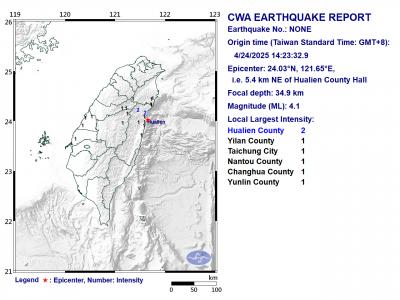Taiwanese researchers yesterday said that they had detailed the structure of filamentous plant viruses by analyzing the structure of a plant virus commonly found in bamboo.
Academia Sinica research fellow Lin Na-sheng (林納生) said that the finding would significantly bolster animal vaccine manufacturing technologies.
The study, co-led by Lin, National Chung Hsing University professor Hsu Yao-heiu (徐堯輝) and US’ University of Virginia professor Edward Egelman, is the first to successfully construct a complete molecular structure of this type of virus, something international scientists have not been able to accomplish over the past 75 years, Lin said.
Filamentous viruses affect more than half of all plant species worldwide, hampering growth and decreasing output, she said.
She said that there are two types of filamentous viruses, rigid or flexible, and that scientists previously only managed to analyze the structure of rigid, rod-like species, as the flexible properties of the second type of virus made its structure extremely difficult to determine.
The bamboo mosaic virus, a virus that affects bamboo in tropical as well as in subtropical regions, including Taiwan, was used for the study, she said.
Using high-resolution X-ray fiber diffraction technology, the scientists first captured images of the virus at near-atomic level with a direct electron detector, she said.
They then constructed a three-dimensional model of the virus using Iterative Helical Real Space Reconstruction software developed by Egelman, Lin said.
She said that an initial model of the bamboo virus was obtained by docking capsid protein extracted from papaya mosaic virus — a similar virus — with the N and C termini knocked off.
The bamboo virus’ N and C termini were subsequently built by using simulation software and the enumerative backbone sampling protocol, which conducted amino acid sequencing of the capsid protein, she said.
After docking the ribonucleic acid structure of the Rift Valley fever virus, which has a similar curvature to the bamboo virus, into the structure to observe how it was encapsidated by the capsid protein and putting the results through computer tests, the scientists concluded that a valid filamentous viral model had been finalized, Lin said.
The model has a resolution of 5.9 angstroms, she said.
She said that filamentous plant viruses have a high structural stability and are therefore excellent vectors for making vaccines targeting animal diseases, such as foot-and-mouth disease.
Lin said that as existing vaccines for foot-and-mouth disease are produced by inactivating viruses, vaccinated swine could end up getting the disease, but now that researchers have a clear understanding of the viral structure, a next-generation, 100 percent safe, vaccine can be developed by embedding peptides — protein segments — of foot-and-mouth viruses in the plant virus.
Hsu said that the method could be used to manufacture human vaccines and pharmaceutical protein products after it passes animal and clinical tests.

PRAISE: Japanese visitor Takashi Kubota said the Taiwanese temple architecture images showcased in the AI Art Gallery were the most impressive displays he saw Taiwan does not have an official pavilion at the World Expo in Osaka, Japan, because of its diplomatic predicament, but the government-backed Tech World pavilion is drawing interest with its unique recreations of works by Taiwanese artists. The pavilion features an artificial intelligence (AI)-based art gallery showcasing works of famous Taiwanese artists from the Japanese colonial period using innovative technologies. Among its main simulated displays are Eastern gouache paintings by Chen Chin (陳進), Lin Yu-shan (林玉山) and Kuo Hsueh-hu (郭雪湖), who were the three young Taiwanese painters selected for the East Asian Painting exhibition in 1927. Gouache is a water-based

A magnitude 4.1 earthquake struck eastern Taiwan's Hualien County at 2:23pm today, according to the Central Weather Administration (CWA). The epicenter of the temblor was 5.4 kilometers northeast of Hualien County Hall, at a depth of 34.9 km, according to the CWA. The earthquake's intensity, which gauges the actual effect of a temblor, was the highest in Hualien County, where it measured 2 on Taiwan's 7-tier intensity scale. The quake also measured an intensity of 1 in Yilan county, Taichung, Nantou County, Changhua County and Yunlin County, the CWA said. There were no immediate reports of damage or injuries.

OFF-TARGET: More than 30,000 participants were expected to take part in the Games next month, but only 6,550 foreign and 19,400 Taiwanese athletes have registered Taipei city councilors yesterday blasted the organizers of next month’s World Masters Games over sudden timetable and venue changes, which they said have caused thousands of participants to back out of the international sporting event, among other organizational issues. They also cited visa delays and political interference by China as reasons many foreign athletes are requesting refunds for the event, to be held from May 17 to 30. Jointly organized by the Taipei and New Taipei City governments, the games have been rocked by numerous controversies since preparations began in 2020. Taipei City Councilor Lin Yen-feng (林延鳳) said yesterday that new measures by

‘WORSE THAN COMMUNISTS’: President William Lai has cracked down on his political enemies and has attempted to exterminate all opposition forces, the chairman said The legislature would motion for a presidential recall after May 20, Chinese Nationalist Party (KMT) Chairman Eric Chu (朱立倫) said yesterday at a protest themed “against green communists and dictatorship” in Taipei. Taiwan is supposed to be a peaceful homeland where people are united, but President William Lai (賴清德) has been polarizing and tearing apart society since his inauguration, Chu said. Lai must show his commitment to his job, otherwise a referendum could be initiated to recall him, he said. Democracy means the rule of the people, not the rule of the Democratic Progressive Party (DPP), but Lai has failed to fulfill his